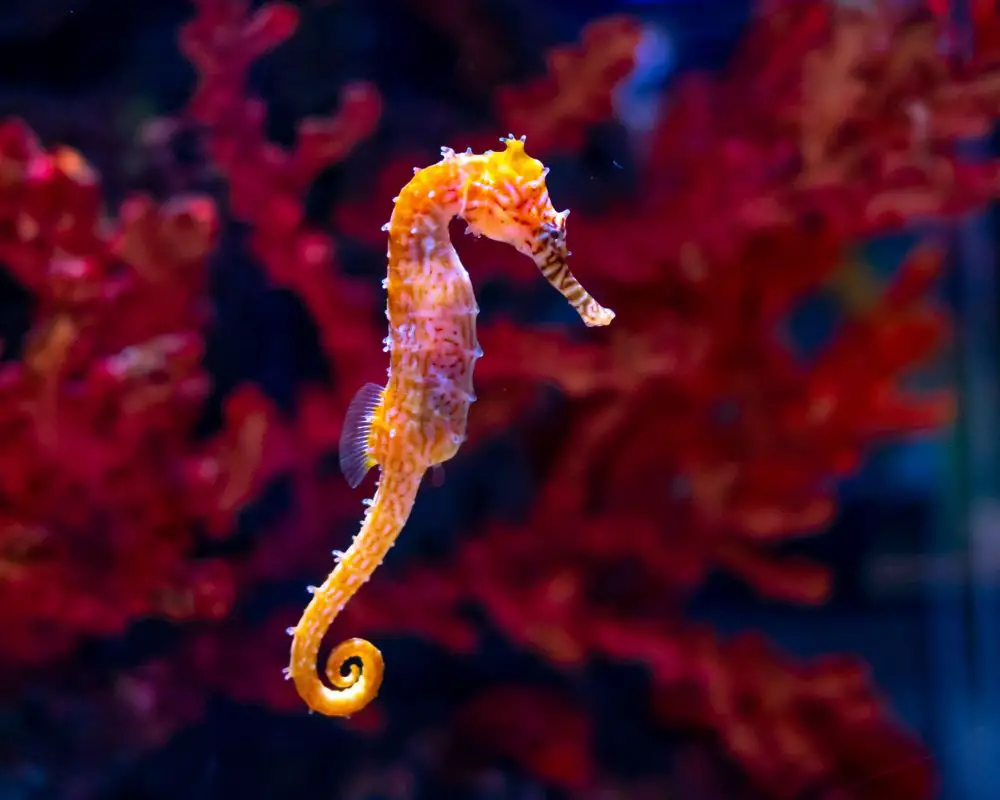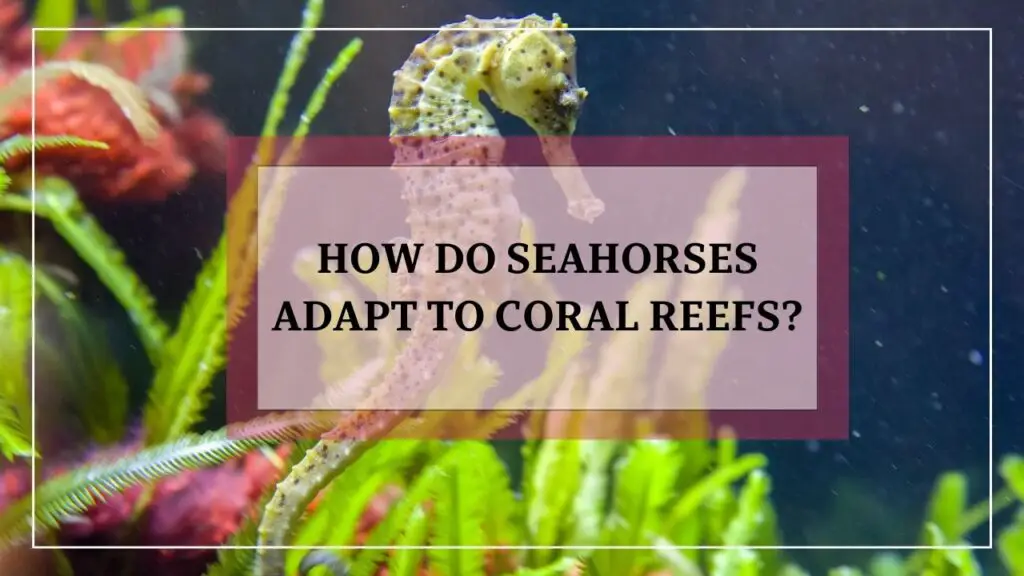Imagine diving into the crystal-clear waters of a tropical paradise, where vibrant coral reefs stretch as far as the eye can see. As you explore this underwater wonderland, you come across a creature so unique and mesmerizing that it captures your attention instantly – the seahorse.
These enchanting beings, with their whimsical appearance and graceful movements, have captivated the imaginations of people for centuries. But have you ever wondered how seahorses manage to thrive in the intricate world of coral reefs?
In this blog post, we will dive into the depths of the ocean to uncover the extraordinary adaptations that allow seahorses to call coral reefs their home. Get ready to embark on a fascinating journey into the hidden world of these incredible creatures.
Exploring the Vibrant World of Coral Reefs

Welcome to the bustling cities of the underwater world – coral reefs! These vibrant and diverse ecosystems are like the Las Vegas of the sea, teeming with life, color, and non-stop action. Just like a busy metropolis, coral reefs provide a home to a dazzling array of marine creatures, including our beloved seahorses.[1]
Seahorse Haven In Coral Reefs
Imagine you’re searching for the perfect place to call home, a cozy neighborhood with all the amenities you need. Well, seahorses have found their version of paradise in coral reefs, and it’s no wonder they’re loving it!
Coral reefs offer the perfect combination of features that make them ideal habitats for seahorses. First of all, these reefs are like natural high-rise apartments, with no shortage of nooks, crannies, and hiding spots. Seahorses love to hang out in the sheltered branches of soft corals and sea fans, blending in with their surroundings like underwater ninjas.
But it’s not just the cool architecture that attracts seahorses. Coral reefs are also renowned for their all-you-can-eat buffet. These reefs are buzzing with life, with an abundance of tiny crustaceans and minuscule fish that seahorses love to snack on. It’s like having a never-ending supply of your favorite snacks delivered right to your doorstep!
Now, what really sets coral reefs apart is their happening social scene. Seahorses are social creatures, and they thrive in environments with plenty of interactions. Coral reefs provide the perfect setting for seahorses to mingle and find potential mates. It’s like attending the hottest party in town, where seahorses can show off their elegant courtship dances and engage in underwater romance.
The Art of Blending In Seahorse Camouflage

Ah, the power of blending in! Just like a ninja hiding in the shadows or your friend who magically disappears during dishwashing duty, seahorses have mastered the art of camouflage. It’s their secret weapon for survival in the bustling coral reef neighborhoods. Let’s dive into the fascinating world of seahorse camouflage and discover how these masters of disguise stay hidden in plain sight.
The Importance Of Camouflage
Now, imagine you’re a seahorse, floating in the colorful coral reef. You want to avoid being the main course at the fish buffet, right? That’s where camouflage comes into play. Camouflage is like a sneaky invisibility cloak that seahorses use to blend seamlessly with their surroundings. It’s their ticket to staying hidden from predators and increasing their chances of snagging that next tasty meal.
Blending In Like A Chameleon
Seahorses are the chameleons of the sea, with a remarkable ability to change their colors to match their environment. It’s like having a built-in fashion sense that can be updated with a flick of the fin. Their skin contains specialized cells called chromatophores that allow them to alter their pigments. So, if a seahorse finds itself among vibrant coral, it can quickly shift its hues to match the surrounding colors. It’s the ultimate fashion statement that keeps them incognito.
But it’s not just the color-changing superpower that helps seahorses disappear. Their body shape and texture also play a crucial role in their disguise. Seahorses have a slender bodies covered in bony plates, which adds another layer of camouflage. These plates, combined with their intricate skin patterns, create a texture that mimics the appearance of coral and other underwater vegetation. It’s like wearing a fancy seahorse camouflage suit!
Masters Of Disguise
Now, let me introduce you to a few seahorse species that take camouflage to a whole new level. The pygmy seahorse is the undisputed champion of disguise. It’s so tiny and well-camouflaged that it often goes unnoticed, even by experienced divers. With its body covered in tubercles resembling coral polyps, this little ninja perfectly merges with its coral home.
These examples just scratch the surface of the seahorse world of disguise. Seahorses have evolved an incredible range of camouflage techniques to suit their specific environments, making each species a unique masterpiece of adaptation.
A Tail Like No Other: The Seahorse’s Secret Weapon
Ah, the incredible prehensile tail of the seahorse! It’s like having a built-in Swiss army knife that helps them navigate the coral reef and perform impressive feats of acrobatics.
Navigating The Coral Maze
Imagine trying to maneuver through a maze of twisting and turning corridors. Well, that’s the daily reality for our seahorse friends in the coral reef. Luckily, their prehensile tail comes to the rescue! This specialized tail acts as a versatile tool, allowing seahorses to anchor themselves to the swaying coral branches and navigate through the intricate labyrinth of their habitat.
With a firm grip, seahorses can hold on tight to coral and other underwater structures, even in the midst of strong currents. It’s like having a built-in GPS and anchor combined, ensuring that they don’t get swept away by the underwater tides. The seahorse becomes a true coral reef explorer, effortlessly gliding through the vibrant underwater world.
A Multi-Purpose Tail
But the prehensile tail isn’t just for navigating the coral reef terrain; it also serves multiple functions during feeding and reproduction. It’s like having a versatile tool that can be adapted to different tasks.
During feeding, seahorses use their tail to anchor themselves in a strategic position, waiting patiently for unsuspecting prey to pass by. With their eyes locked on the target, they strike with lightning speed, snatching up their prey using their tubular snout.
It’s like watching an underwater ninja execute a perfectly timed mission!
Reproduction is where the sea horse’s tail truly shines. In an extraordinary role reversal, the male seahorse carries and incubates the eggs.
When it’s time for mating, the female seahorse deposits her eggs into a special pouch located on the male’s abdomen.
The male then uses his prehensile tail to protect and nurture the developing embryos. It’s like witnessing the ultimate act of fatherly love and care.
Mouth Adaptations
Now, let’s take a peek into the dining habits of our seahorse friends. These elegant creatures have a unique set of mouth adaptations that make them the ultimate connoisseurs of the coral reef menu. Get ready to be wowed by their feeding behavior and hunting strategies that would put even the most sophisticated food critics to shame!
Hunting Strategies In The Coral Reef
These habitats can be crowded with countless potential prey items, so seahorses have to be strategic in their approach.
Seahorses are patient hunters, choosing to lie in wait for their prey rather than actively chasing it down. They position themselves near coral branches or other structures, blending in with their surroundings like undercover agents. With their keen eyesight, they carefully track the movements of their prey, waiting for the perfect moment to strike. It’s like watching a seahorse spy mission unfold!
Their camouflage skills also come into play during hunting. By perfectly blending in with the coral, seahorses can remain undetected, giving them the element of surprise when the time comes to pounce on their unsuspecting prey. It’s like witnessing a hidden predator in action, striking with deadly precision.
Navigating Within The Coral Reefs
Now that we’ve explored the seahorse’s hidden talents, let’s dive into their remarkable mobility and locomotion within the coral reef. From their delicate pectoral fins to their trusty prehensile tail, seahorses have developed some nifty tricks to maneuver through their vibrant underwater playground. Get ready to be amazed by their underwater dance moves!
Pectoral Fins: The Seahorse’s Steering Wheel
Imagine you’re exploring a crowded street, trying to navigate through a sea of people. Well, seahorses face a similar challenge in the bustling coral reef. To tackle this obstacle course, they rely on their pectoral fins. These delicate, fan-like fins located on either side of their head act as their steering wheel, allowing them to gracefully move through the water with precision.
Seahorses use their pectoral fins to adjust their position, make subtle turns, and even hover in place. It’s like watching a seahorse ballet, with each movement executed with elegance and finesse. These fins are not just for show; they’re the seahorse’s secret weapon for mobility within the intricate coral reef environment.
The Tail’s Anchoring Power
We’ve already discussed how the seahorse’s prehensile tail is a versatile tool for navigating and securing its grip within the coral reef. But did you know it also plays a role in their overall mobility?
Seahorses are excellent anchor artists, using their prehensile tails to hold on tight to coral branches and other underwater structures. It’s like having a built-in grappling hook! By firmly anchoring themselves, seahorses can withstand the gentle swaying of the coral reef and avoid being swept away by ocean currents.
This anchoring ability not only helps seahorses maintain their position but also allows them to conserve energy. By latching onto their surroundings, they can take a break from swimming and let the currents do the work. It’s like having a cozy seahorse hammock where they can rest and observe the vibrant coral reef community.
Conclusion
In conclusion, the seahorse’s adaptation to coral reefs is truly awe-inspiring. From their ability to blend seamlessly with their surroundings through camouflage and coloration, to their unique feeding strategies and intricate reproductive behaviors, seahorses have carved out their own niche in the underwater world.
Their prehensile tail serves as a multifunctional tool for navigation, feeding, and even parenting. With their delicate pectoral fins and masterful anchoring skills, seahorses navigate the bustling coral reef with finesse and grace. They are a testament to the incredible diversity and ingenuity of marine life.

Hi, I’m Ali Tarek, the founder of Animalsman. I’ve always been passionate about pets, especially dogs and cats, and I created this website to share practical tips, easy recipes, and helpful care advice for fellow pet lovers. My goal is to make pet care simple, enjoyable, and accessible for everyone. When I’m not writing or curating content, you’ll usually find me spending time with my furry friends or learning new ways to keep them happy and healthy.



